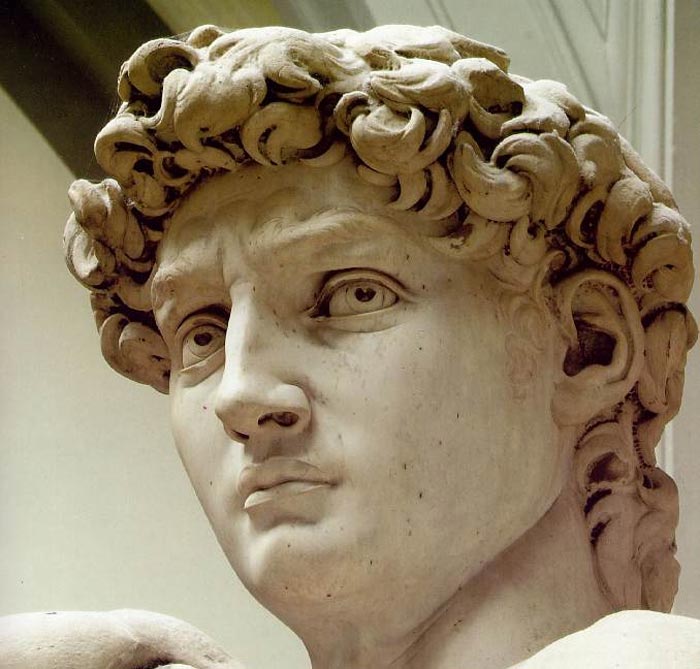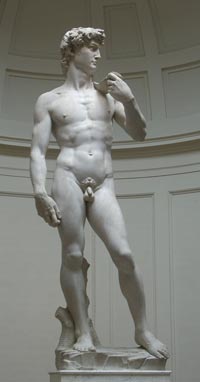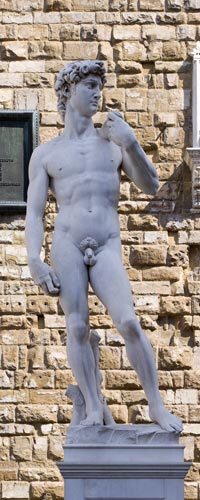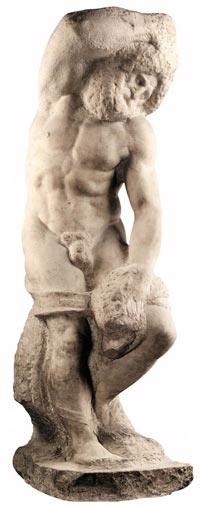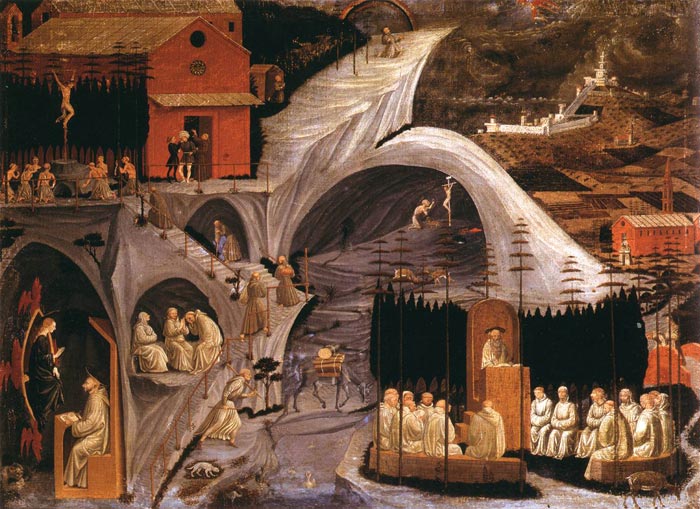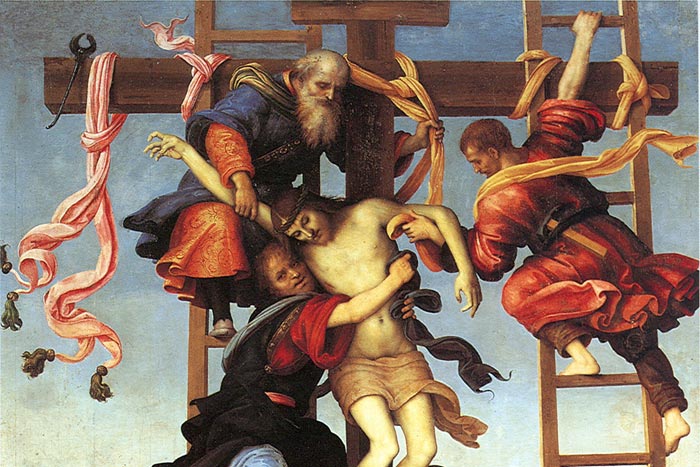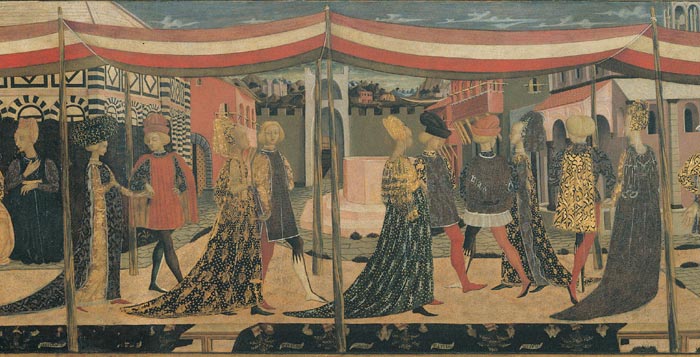| |
|

Paintings in the Galleria dell'Accademia
Sculptures in the Galleria dell'Accademia
|
|
|
 |
|

|
|
 |
| Barnardo Daddi |
|
Sandro Botticelli
|
|
Domenico Ghirlandaio
|
 |
|
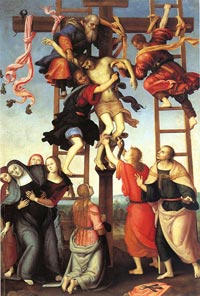
|
|
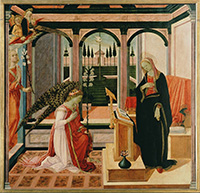
|
Giovanni da Milano
|
|
Filippino Lippi e Pietro Perugino, Polittico dell'Annunziata
|
|
Filippino Lippi e Maestro della Natività |
| |
|
|
|
|

|
|
 |
|

|
Filippino Lippi
|
|
Filippino Lippi |
|
Lorenzo Monaco |
 |
|

|
|
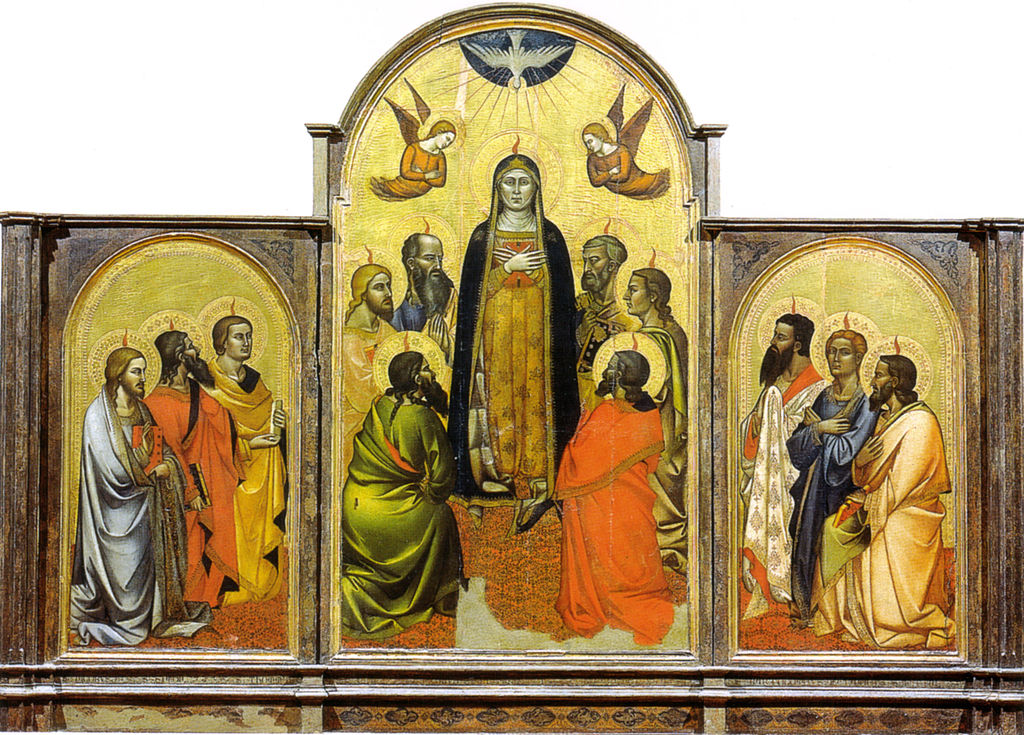 |
| Lorenzo Monaco |
|
Nardo di Cione |
|
Orcagna e Jacopo di Cione |
| |
|
|
|
|
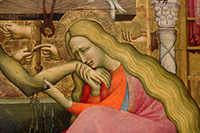 |
|
|
|
|
| Maestro della Madonna Strauss |
|
|
|
|
| |
|
|
|
|
| |
|
|
|
|
| |
|
|
|
|
| |
|
|
|
|
| |
|
|
|
|
| |
|
|
|
|
| |
|
|
|
|
| |
|
|
|
|
| |
|
|
|
|
| |
|
|
|
|
| |
|
|
|
|
| |
|
|
|
|
| |
|
|
|
|
| |
|
|
|
|
| |
|
|
|
|
| |
|
|
|
|
| |
|
|
|
|
| |
|
|
|
|
| |
|
|
|
|
Opere della Galleria dell'Accademia
|
|
|
Sala del Colosso
La sala del Colosso deve il suo nome al gigantesco gesso di uno dei Dioscuri di Montecavallo che un tempo si trovava qui e che oggi è alla Gipsoteca dell'Istituto d'Arte di Porta Romana. Oggi al centro si trova il bozzetto originale in gesso del Ratto delle Sabine di Giambologna, mentre alle pareti si trovano numerosi esempi di pittura fiorentina del Quattro e Cinquecento fiorentino, con opere di grandi maestri (Paolo Uccello, Botticelli, Perugino, Filippino Lippi, Ghirlandaio) e altre che documentano l'attività delle botteghe cittadine.
Opere presenti:
|
- Giambologna, Ratto delle Sabine, modello in gesso, 1582
- Alesso Baldovinetti, Trinità e santi, 1472 circa
- Andrea Del Sarto, Cristo in pietà, 1526 circa
- Andrea di Giusto Manzini:
- Madonna col Bambino e Cristo in pietà, 1435 circa
- Madonna della Cintola e santi, 1437
- Bartolomeo di Giovanni, Annunciazione, santi e profeti, 1490 circa
- Benozzo Gozzoli, Santi Bartolomeo, Giovanni Battista e Giacomo Maggiore, 1461–62 circa
- Biagio d'Antonio, Angelo annunciante; Eterno Padre; Vergine annunciata, 1475 circa
- Cosimo Rosselli (bottega), Madonna col Bambino incoronata da due angeli (detta Madonna della Stella)
- Cosimo Rosselli:
- Noè e David; Mosè e Abramo, 1460 circa
- Santi Barbara, Giovanni Battista e Matteo, 1470 circa
- Domenico di Michelino:
- Santi Michele Arcangelo, Lorenzo e Leonardo, 1469
- Tre Arcangeli e Tobiolo, 1465 circa
- Trinità, 1460-70 circa
- Domenico Ghirlandaio, Santo Stefano tra i santi Jacopo e Pietro, 1493
- Filippino Lippi e Perugino, Deposizione dalla croce, 1503-1507
- Filippino Lippi:
- San Giovanni Battista
- Maria Maddalena, 1500 circa
- Fra Bartolomeo:
- Francesco Botticini
- Sant'Agostino e Santa Monica, 1471
- Sant'Andrea Apostolo in adorazione della croce, 1475–1499 circa
- Francesco Granacci:
- Assunzione della Vergine e santi, 1520
- Madonna col Bambino e santi, 1508 circa
- Madonna della Cintola, 1500-1520 circa
- Martirio di una santa; Martirio di una santa; Una santa davanti al giudice; Martirio di santa Caterina; Disputa di santa Caterina d'Alessandria; Martirio di sant'Apollonia, 1530
- Franciabigio, Madonna col Bambino, san Giuseppe e san Giovannino, 1508-1510
- Gherardo di Giovanni:
- Adorazione del Bambino con San Giovannino, 1475-1480
- Madonna in trono con Bambino e santi, 1470-1495 circa
- Giovan Francesco da Rimini, San Vincenzo Ferrer, 1455 circa
- Giovanni Antonio Sogliani, Disputa sull'Immacolata Concezione, 1521 circa
- Ignoto fiorentino:
- Annunciazione, 1490 circa
- Cristo in pietà tra la Vergine e San Giovanni, 1475-1500
- Eterno Padre, 1500-1524 circa
- Martirio di san Lorenzo, 1480 circa
- Trinità e santi, 1470 –1480 circa
- Jacopo del Sellaio:
- Cristo deposto nel sepolcro, 1480 circa
- Deposizione e santi, post 1480
- Lo Scheggia, Cassone Adimari, 1440-1450 circa
- Lorenzo di Credi, Adorazione del Bambino, 1480-1490 circa
- Maestro degli angeli di carta (bottega di Domenico di Michelino),Madonna col Bambino e santi, 1460-1470 circa
- Maestro della Natività di Castello, Natività, 1455-1460
- Maestro della Natività Johnson e Filippino Lippi, Annunciazione, 1460 circa, poi 1472
- Maestro dell'epifania di Fiesole, Incoronazione della Vergine, 1475-1480
- Mariotto Albertinelli:
- Trinità, 1510 circa
- Annunciazione, 1510
- Neri di Bicci:
- Annunciazione, 1464
- San Francesco, San Filippo, Santa Caterina d'Alessandria, San Girolamo, 1444-1453 circa
- Paolo Uccello, Tebaide, 1450-1460 circa
- Perugino (attr.), Visitazione con sant'Anna, 1472-1473 circa
- Perugino, Pala di Vallombrosa, 1500
- Pseudo Pier Francesco Fiorentino, Adorazione del Bambino, post 1459
- Raffaellino del Garbo, Resurrezione di Cristo, 1500-1505 circa
- Ridolfo del Ghirlandaio:
- Madonna col Bambino e santi, 1503
- Tre angeli oranti; Tre angeli oranti, 1508
- Sandro Botticelli (attr.), Madonna del Mare, 1477 circa
- Sandro Botticelli e bottega, Madonna col Bambino e santi, 1480-1500
- Sandro Botticelli, Madonna col Bambino, due angeli e Giovanni Battista, 1468-1470 circa
|
Galleria dei Prigioni
La galleria dei Prigioni deve il suo nome alle quattro sculture raffiguranti nudi maschili, dette Prigioni, realizzate da Michelangelo per la tomba di Giulio II, ma usate dal Granduca Cosimo I de' Medici, come ornamentazioni angolari della grotta del Buontalenti nel Giardino di Boboli e pervenute in galleria nel 1909. Vi si trovano inoltre Pietà di Palestrina, acquisita nel 1939, e il San Matteo, mentre alle pareti sono esposte opere cinquecentesche.
Un tempo ha ospitato i "Quadri antichi", accostati l'uno all'altro fino al soffitto, poi i calchi michelangioleschi, con alle pareti una serie di arazzi, mentre oggi le opere originali di Michelangelo o della sua scuola sono pausate in maniera studiata, per introdurre il visitatore, in un crescendo emotivo, ai piedi del David[1].
|
Opere presenti:
- Andrea del Sarto, Cristo in pietà, 1525 circa
- Daniele da Volterra, Busto di Michelangelo, 1560 circa
- Francesco Granacci, Madonna col bambino e santi, 1510 circa
- Mariotto Albertinelli, Annunciazione, 1510
- Michelangelo Buonarroti (attribuzione incerta), Pietà di Palestrina, 1560 circa
- Michelangelo Buonarroti:
- San Matteo, 1505-1506
- Prigione detto Atlante, 1530 circa
- Prigione detto lo schiavo barbuto, 1530 circa
- Prigione detto lo schiavo che si ridesta, 1530 circa
- Prigione detto lo schiavo giovane, 1530 circa
- Michele di Ridolfo del Ghirlandaio:
- Zenobia, 1560-1570 circa
- Testa femminile ideale, 1560-1570 circa
- Pontormo su cartone di Michelangelo, Venere e Amore, 1533 circa
- Ridolfo del Ghirlandaio:
- San Zanobi resuscita un fanciullo, 1516 circa
- Traslazione del corpo di san Zanobi, 1516 circa
-
|
Tribuna del David
La sala ospita dal 1873 il David di Michelangelo, realizzato fra il 1501-04 e proveniente da piazza della Signoria. La sala prosegue nei due bracci laterali, dove si trovano opere di scuola manierista.
|
Opere presenti:
- Michelangelo Buonarroti, David, 1501-1504
- Alessandro Allori:
- Annunciazione, 1579
- Annunciazione, 1603
- Battesimo di Cristo, 1591
- Incoronazione della Vergine, 1593
- Madonna col Bambino e santi, 1575
- Bronzino, Deposizione, 1561
- Carlo Portelli, Disputa sull'Immacolata Concezione, 1566
- Cosimo Gamberucci, San Pietro guarisce lo storpio, 1599
- Francesco Salviati, Madonna col Bambino, san Giovannino e un angelo, 1540-1550 circa
- Giuliano Bugiardini, Madonna col Bambino e san Giovannino, 1520
- Il Poppi, Figura allegorica, 1572-1573 circa
- Maso da San Friano:
- Allegoria della forza, 1550-1599 circa
- Trinità e santi, 1560-1570
- Pier Francesco di Jacopo Foschi, Madonna col Bambino e san Giovannino, 1525-1535 circa
- Santi di Tito:
- Cristo deposto dalla Croce con la Vergine e santi, 1576–1600
- Entrata di Cristo in Gerusalemme, 1569-1579
- Stefano Pieri:
- Deposizione, 1587
- Il Sacrificio di Abramo, 1585
- Pittore vasariano, Santa Barbara, 1570 circa
|
Gipsoteca Bartolini (Salone dell'Ottocento)
Conosciamo l'aspetto antico del salone, ricavato dalla corsia delle donne dell'antico Ospedale di San Matteo, da un affresco a monocromo realizzato dal Pontormo e ivi conservato.
Oggi l'allestimento ospita una raccolta di dipinti e sculture di artisti del XIX secolo in rapporto con l'Accademia di Belle Arti, tra cui i gessi di Lorenzo Bartolini, con le opere disposte com'erano state messe dall'artista nel suo studio di borgo San Frediano a Firenze e quelli di Luigi Pampaloni.
I dipinti sono alcune delle opere esposte in occasione dei concorsi di pittura, svolti fra il 1794 e il 1868, dell'Accademia dei Belle Arti.
|
Opere presenti:
- Antonio Puccinelli:
- Gli Ebrei in Babilonia, 1851
- La strage degli Innocenti, 1852
- Baldassarre Calamai, Dante, Virgilio e Farinata degli Uberti, 1825
- Benedetto Servolini:
- Morte di Filippo Strozzi, 1835
- Orlando si impadronisce del cavallo, 1834
- Cesare Mussini:
- Francesco I presso Leonardo morente, 1828
- La morte di Atala, 1830
- La Musica Sacra, 1830
- Demostene Macciò, Fra Benedetto da Foiano in carcere
- Eugenio Prati, Il Barocci presentato a Michelangelo, 1868
- Francesco Nenci, Edipo sciolto dai lacci da un pastore, 1817
- Francesco Pozzi, Baccante con Fauno e Pantera, 1851
- Francesco Pozzi, Ciparisso, 1818
- Francesco Sabatelli, Copia dell'Assunta di Tiziano, 1827
- Giuseppe Colignon, La decollazione del Battista, 1860 circa
- Giuseppe Fattori, Il Battista rimprovera Erode, 1856
- Irene Duclos Parenti, Copia della Madonna del Sacco di Andrea del Sarto, 1775
- Leopoldo Neofreschi, Alessandro Magno si accinge a bere alla coppa avvelenata, 1794
- Lorenzo Bartolini (atelier), Ninfa, XIX secolo
- Lorenzo Bartolini:
- Alberto Adamo Neipperg, 1829-1830
- Alberto Adamo Neipperg, 1825-1830
- Amore, Post 1841
- Anatol Demidoff, ante 1850
- Angelo, post 1815
- Baccante, 1823 circa
- Bassorilievi per il monumento a Luigi Guglielmo Cambray Digny, 1844
- Bassorilievo per il monumento a Maria Temple Bowdoin, 1822 circa
- Beatrice Donati, 1846
- Carlo Lodovico di Borbone, 1823
- Carlotta Bonaparte, ante 1850
- Carolina Ungher, ante 1850
- Casimir Delavigne, 1830-1840
- Caterina di Westfalia, 1815-1830
- Conte Gourief, ante 1850
- Emilia Della Gherardesca?, ante 1850
- Emma e Giulia Campbell, 1819-1820 circa
- Eveline Hanska de Balzac, ante 1850
- Francesco Benedetti, 1815-1820
- Francesco I d'Asburgo, ante 1850
- Franz Liszt, 1838-1839
- George Gordon Byron, 1822
- Giovanni Battista Niccolini, ante 1850
- Giunone, 1823-1830 circa
- Giuseppe Bonaparte principe di Canino e Musignano, 1829
- Guelfo Trotti Estense Mosti, ante 1850
- Il Voto dell'Innocenza, 1848
- Jean Auguste Dominique Ingres, post 1815
- Jonathan Hatfield, ante 1850
- Klemens Wengel Lothar Metternich-Winneburg, 1821 circa
- La Carità educatrice, 1817-1824
- La Carità educatrice, bozzetto, 1820-1830
- La gara fraterna, ante 1847
- La Ninfa del Serpe, ante 1840
- La Ninfa dello Scorpione, ante 1840
- La Tavola degli Amori, ante 1845
- La Venere di Tiziano, 1821 circa
- Lady Burglesh, ante 1850
- Lady Gowen?, ante 1850
- Lady Harriet Pellew, ante 1850
- Lady Mary Tighe, 1820 circa
- L'Ammostatore, 1816-1820 circa
- L'Orante per il monumento a Pietro Recchi, 1838
- Luciano Bonaparte, 1815-1830 circa
- Luigi Vestri, 1830-1840
- Luisa Carlotta di Borbone, 1825 circa
- Luisa Sauli Pallavicini, ante 1850
- Madame Germaine de Stael, 1815-1820
- Marchesa di Bristol, ante 1850
- Marchese di Londonderry, ante 1850
- Marco Paolini, ante 1850
- Maria Carolina di Sassonia, granduchessa di Toscana, ante 1832
- Maria Luisa di Borbone, 1823
- Marie D'Agoult, 1838-1839
- Matilde Demidoff, ante 1850
- Matilde Demidoff', ante 1850
- Medaglione con profilo maschile, post 1815
- Medaglione con profilo maschile, post 1815
- Medaglione con profilo maschile, post 1815
- Medaglione per il monumento a Girolamo Segato, 1838-1844
- Monumento a Elisa Baciocchi, 1808-1813
- Monumento a Leon Battista Alberti, Post 1838
- Monumento a Niccolò Demidov, 1830-1870
- Monumento a Sofia Zamoiska, 1837-1844
- Monumento a Vittorio Fossombroni, 1846
- Monumento a Ortensia Beauharnais, 1838-1845
- Monumento al conte Alberto Adamo di Neipperg, 1829-1841
- Monumento funebre al conte Giovan Francesco Mastiani Brunacci, 1846 circa
- Mr Morrison, ante 1850
- Mrs Morrison, ante 1850
- Narciso, 1825-1850
- Niccolò Machiavelli, 1845-1846
- Nicola Demidoff, ante 1850
- Ortensia Beauharnais, 1815-1830 circa
- Ortensia Beauharnais, 1815-1830 circa
- Paolina Borghese?, ante 1850
- Rilievi per il monumento a Enrichetta Stratford Canning, 1818 circa
- Rilievo con cinque figure, post 1815
- Rilievo con figura alata, post 1815
- Rilievo con figura maschile, post 1815
- Rilievo con figura maschile, post 1815
- Rilievo con figura maschile, post 1815
- Rilievo con figure, post 1815
- Rilievo con figure, post 1815
- Rilievo frammentario: la Giustizia che protegge l'Innocenza, post 1815
- Rilievo per il monumento a Carolina Hungher, post 1815
- Ritratto di Anne Lullin de Châteauvieux sposata Eynard, 1820-1822
- Ritratto di bambina, 1820-1825 circa
- Ritratto di Frances Anne Vane-Tempest, marchesa di Londonderry, con il figlio George, 1823
- Salvatore Vigano, 1815-1820
- Sofia Scerbatova Apraxina, ante 1850
- Teti che accarezza Giove, post 1815
- Thomas Moore, ante 1850
- Venere, 1817 circa
- Luigi Mussini, L'elemosina secondo la carità angelica e secondo la mondana ostentazione, 1844
- Luigi Pampaloni:
- Amore con Cigno, post 1834
- Amore, 1833
- Arnolfo di Cambio, 1827-1830
- Bambina giacente, 1826 circa
- Bassorilievo per il monumento funebre di Annamaria Frescobaldi, 1842-1844
- Cloe, 1834
- Fanciulla orante (Orfana sulla rupe), 1838-1842
- Fanciullo che scherza con un cane, 1827
- Fanciullo orante (Orfano sulla rupe), 1826-1827
- Filippo Brunelleschi, 1827-1830
- La Fanciulla delle Tortore, 1831
- Maddalena penitente, 1870 circa
- Medaglione di Luigi Magalotti
- Monumento a Giulia Clary Bonaparte: la Beneficenza, 1846 circa
- Monumento a Lazzaro Papi, 1835 circa
- Monumento a Maria Radzwill Kranzinski con il figlio Zìgmunt, 1839-1841
- Monumento a Virginia de Blasis, 1839 circa
- Monumento a Wanda Wancowicz Tyskiewicz, 1842-1845
- Rilievi per il monumento a Luciano Bonaparte principe di Canino, 1840-1847
- Luigi Pampaloni, Rilievo per il monumento Tellinson, 1840 circa
- Odoardo Borrani, Alla Galleria dell'Accademia, 1860-1870
- Pontormo, Tre storie della Beata Umiltà da Faenza, 1514 circa
- Raffaello Sorbi, Morte di Corso Donati, 1861
- Silvestro Lega, David calma i furori di Saul con l'arpa, 1852
- Ulisse Cambi:
- Aconzio, 1835
- Dafni e Cloe, 1834
|
Sala del Duecento e del primo Trecento
Da questa sala inizia un percorso sulla pittura gotica fiorentina che attinge al cospicuo deposito di tavole a fondo oro della galleria. La sala centrale, del Duecento e del primo Trecento, espone dipinti precedenti a Giotto o suoi contemporanei, con un raro frammento attribuito a Giotto stesso proveniente dalla Badia fiorentina.
|
Opere presenti:
- Grifo di Tancredi, Madonna col Bambino e santi, 1300 circa
- Guido da Siena, Madonna in trono col Bambino, 1270-1275 circa
- Maestro del Crocifisso Corsi, Cristo crocifisso fra i dolenti e il committente genuflesso, 1315 circa
- Maestro della Maddalena, Maddalena penitente e otto storie della sua vita, 1280-1285
- Maestro della Maddalena, San Giovanni evangelista e storie della sua vita; San Jacopo e storie della sua vita, 1280-1290
- Maestro della Santa Cecilia, Maestà, 1320-1325
- Pacino di Buonaguida:
- Crocifissione e santi, 1315-1320
- Albero della Vita, 1305-1310 circa
- Madonna col Bambino, 1320-1339 circa
- San Nicola; San Giovanni Evangelista; San Procolo, 1305-1310
- Pittore fiorentino:
- Croce dipinta, 1290 circa
- Madonna col Bambino, 1250-1260 circa
- Pittore lucchese, Madonna col Bambino e due angeli, 1240-1250 circa
|
Sala dei giotteschi
La sala è allestita con opere di artisti fiorentini del XIV secolo seguaci di Giotto.
|
Opere presenti:
- Bernardo Daddi e Puccio di Simone, Crocifissione con i dolenti e la Maddalena ai piedi della Croce; Santa Maria Maddalena, san Michele Arcangelo, san Giuliano, santa Marta
- Bernardo Daddi:
- Crocifisso con i dolenti e storie della Passione, 1338-1343
- Crocifissione, 1343
- Crocifissione; San Cristoforo, 1340-1348 circa
- Incoronazione della Vergine con angeli e 42 santi, 1340-1348
- Madonna col Bambino e santi; Crocifissione; Incontro dei tre vivi con i tre morti, 1340 circa
- Madonna in trono con Bambino e santi, 1333
- San Bartolomeo; San Lorenzo, 1340 circa
- Giotto e bottega, Testa di pastore, 1315, 1325
- Jacopo del Casentino:
- San Bartolomeo e angeli, 1340 circa
- Sant'Egidio; San Giovanni Battista; San Giovanni Evangelista
- Maestro delle effigi domenicane, Incoronazione della Vergine e santi; Madonna col Bambino e santi, 1340-1345
- Niccolò di Pietro Gerini, Cristo benedicente e due profeti; Cristo in pietà tra la Vergine e san Giovanni Evangelista e santi, 1390-1410 circa
- Puccio di Simone, Polittico della Madonna dell'Umiltà e santi, 1350-1360
- Taddeo Gaddi:
- Formelle dell'armadio della sacrestia di Santa Croce, 1330-1340
- Madonna col Bambino e angelo annunziante; San Giovanni Battista e san Pietro e Vergine annunciata, 1345-1350
- Madonna col Bambino, 1355 circa
- Madonna in trono tra due angeli e quattro santi, 1330-1335 circa
|
Sala degli Orcagna e dei loro seguaci
La sala deve il suo nome all'esposizione di opere realizzate dai tre fratelli pittori, attivi a Firenze nel XIV secolo, l'Orcagna, ovvero “arcangelo” (Andrea di Cione), Nardo di Cione e Jacopo.
|
Opere presenti:
- Andrea Orcagna:
- Pentecoste, 1365 circa
- Madonna in trono con Bambino e santi, 1355 circa
- Jacopo di Cione:
- Cristo crocifisso fra la Vergine e San Giovanni con quattro angeli, 1380-1398 circa
- Incoronazione della Vergine, 1372-1373
- Madonna dell'Umiltà, 1380 circa
- Maestro della Cappella Rinuccini (Matteo di Pacino):
- Elemosina di sant'Antonio Abate, post 1370
- Santi Michele Arcangelo, Bartolomeo, Giuliano e una donatrice, post 1348
- Visione di san Bernardo e santi, 1365 circa
- Maestro della predella dell'Ashmolean Museum, San Lorenzo; Santo Vescovo, 1360-1365 circa
- Maestro dell'altare di San Niccolò, Madonna dell'Umiltà e quattro angeli, 1350-1380
- Maestro dell'infanzia di Cristo (Jacopo di Cione?):
- Episodi dell'Infanzia di Cristo, 1365-1375 circa
- Madonna col Bambino; Annunciazione; Crocifissione e santi, 1380-1399 circa
- Nardo di Cione, Trittico del Thronum Gratiae, 1365
- Niccolò di Tommaso, Incoronazione della Vergine con angeli e santi, 1370
|
Sala di Giovanni da Milano
|
Opere presenti:
- Andrea Buonaiuti, Sant'Agnese; Santa Domitilla, 1365 ca
- Cenni di Francesco, Madonna col Bambino fra otto santi e quattro angeli, 1380-1390
- Don Silvestro dei Gherarducci, Madonna dell'Umiltà e Angeli, 1370-1377 circa
- Giottino (attr.), Madonna col Bambino in trono con santi e angeli, 1360 circa
- Giovanni da Milano, Cristo in pietà, 1365
- Giovanni del Biondo-San Giovanni Evangelista in trono, 1380-1385
- Ignoto fiorentino, Incoronazione della Vergine e santi, 1390-1399
- Maestro della Misericordia dell'Accademia (Giovanni Gaddi?):
- Madonna col Bambino fra i santi Pietro e Paolo, 1360 circa
- Madonna col Bambino in trono e otto santi, 1380 circa
- Madonna della Misericordia, 1380 circa
- Stigmate di san Francesco, Natività, Conversione di san Paolo, 1370-1375
- Maestro della predella dell'Ashmolean Museum, Madonna col Bambino, 1370-1390 circa
- Maestro dell'Annunciazione dei Linaioli e Mariotto di Nardo,Annunciazione; Natività, Epifania, Presentazione al tempio, profeti, 1350-1360; 1390-1400
|
Sala del tardo Trecento
La sala è allestita con opere realizzate fra la fine del XIV secolo e l'inizio del XV, di Giovanni del Biondo, Mariotto di Nardo, Rossello di Jacopo Franchi, Spinello Aretino. Nella sala il paliotto ricamato con fili d'oro, d'argento, e di seta policroma da Jacopo Cambi nel 1336.
|
Opere presenti:
- Agnolo di Domenico del Mazziere, Quattro Evangelisti, inizio XV secolo
- Bicci di Lorenzo:
- San Paolo; San Benedetto; San Giovanni Gualberto; San Pietro, 1430-1435
- Sant'Andrea e san Michele; San Girolamo e san Lorenzo, 1420-1430
- Santi apostoli, 1420-1425
- Cenni di Francesco, Natività, 1395-1400
- Giovanni Dal Ponte:
- Polittico dell'incoronazione della Vergine e santi, primi decenni del Quattrocento
- San Giacomo; Sant'Elena, 1420-1430
- San Giuliano; San Giovanni Battista, 1430 circa
- Giovanni del Biondo:
- Polittico con l'Annunciazione e santi, 1380–1385 circa
- Presentazione al Tempio tra san Giovanni Battista e san Benedetto, 1364
- Jacopo Cambi, Incoronazione della Vergine fra otto angeli e quattordici santi, 1336
- Lippo d'Andrea, Madonna in trono con Bambino e santi, 1430-1440
- Lorenzo di Bicci:
- San Giuliano e san Zanobi, 1380-1400 circa
- San Martino in trono; Elemosina di san Martino, 1385-1389 circa
- Lorenzo di Niccolò, Incoronazione della Vergine e quattro angeli musicanti; San Zanobi; San Bartolomeo, 1400-1410 circa
- Maestro di Borgo alla Collina, Crocifissione tra la Vergine, san Francesco e un donatore, prima metà del Quattrocento
- Maestro "Francesco", Madonna col Bambino tra due angeli e due santi, 1391
- Mariotto di Nardo:
- Annunciazione, 1400-1410 circa
- Crocifissione e quattro storie di san Nicola, 1415 circa
- Madonna col Bambino e santi, 1380-1400 circa
- Madonna col Bambino e santi, 1418
- Madonna col Bambino e santi; Angelo Annunciante; Crocifissione; Vergine Annunciata; Storie della Vergine
- Niccolò di Pietro Gerini:
- Cristo in Pietà con i simboli della Passione; Il Redentore e santi; Le esequie di un confratello, 1404–1408 circa
- Crocifissione con San Francesco adorante e santi, 1390-1400 circa
- La Santissima Trinità con san Francesco e santa Maria Maddalena, 1385 circa
- Madonna col Bambino e santi, 1404
- Madonna col Bambino e santi, 1410 circa
- Madonna col Bambino in trono e due santi, 1400 circa
- Pittore fiorentino, Madonna dell'Umiltà fra due angeli, 1390-1399 circa
- Rossello di Jacopo Franchi:
- Incoronazione della Vergine con angeli e santi, 1422 (?)
- San Giovanni Battista; San Francesco, 1400-1410 circa
- Spinello Aretino, Niccolò di Pietro Gerini e Lorenzo di Niccolò, Incoronazione della Vergine, angeli e santi, 1401
- Spinello Aretino:
- Santo Stefano, 1400-1405
- Trittico della Madonna in trono e santi, 1391
|
Sala di Lorenzo Monaco
La sala presente un'importante raccolta di opere realizzate da Lorenzo Monaco. In essa è entro una nicchia una raccolta di icone russe appartenute alla famiglia granducale dei Lorena.
|
Opere presenti:
- Agnolo Gaddi:
- Madonna del Latte e santi, 1380 circa
- Madonna dell'Umiltà con sei angeli, 1395 circa
- Andrea Ritzos (o Rico), Madonna col Bambino e angeli con gli strumenti della Passione, 1450-1490
- Bartolomeo di Fruosino, Croce sagomata e dipinta, 1411 circa
- Lorenzo Monaco e Maestro della predella Sherman, Madonna del latte con santi e angeli; Annunciazione, Crocifissione con dolenti, santi, 1390 circa, 1425–1430
- Lorenzo Monaco:
- Orazione nell'orto, 1395-1400
- Polittico della Madonna in trono e santi, 1410
- Trittico dell'Annunciazione, 1410 circa
- Cristo in Pietà con i simboli della Passione, 1404
- Croce dipinta, 1400–1410 circa
- Crocifissione; Vergine dolente; San Giovanni Evangelista, 1405-1410
- Madonna col Bambino e santi, 1408 d.
- Madonna col Bambino in trono fra i santi Giovanni Battista, Lucia, Antonio Abate, Pietro, Giuliano e Caterina, 1395-1400 circa
- Redentore benedicente, 1410-1415
- San Moisè; san Giovanni Battista; san Pietro; san Paolo, 1395 circa
- Santa Caterina d'Alessandria, san Caio Papa, 1390-1400
- Maestro della predella Sherman, Crocifissione, 1415-1430
- Mariotto di Cristofano, Episodi della vita di Cristo e della Vergine, post 1450
|
Sala del Gotico internazionale
La sala è allestita con opere del gotico internazionale.
|
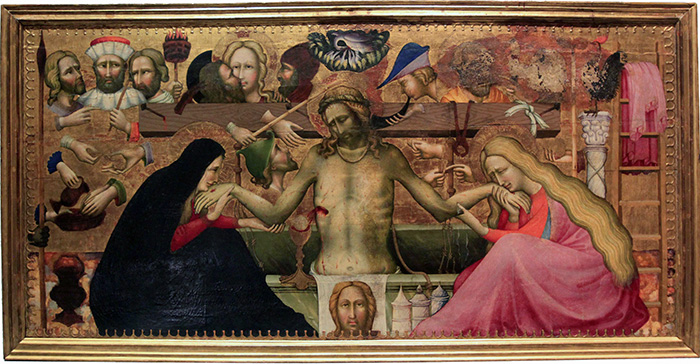 |
Maestro della Madonna Strauss, Cristo in pietà tra la Madonna e santa Maria Maddalena con simboli della Passione,
Firenze, Galleria dell'Accademia
|
Opere presenti:
- Bicci di Lorenzo:
- Matrimonio mistico di santa Caterina, 1423-1425
- San Lorenzo, 1420-1430 circa
- Gherardo Starnina, Madonna col Bambino, santi e angeli, 1400,1410 circa
- Giovanni Toscani, Crocifissione; Stigmate di san Francesco e un miracolo di san Nicola di Bari, 1423-1424 circa
- Giovanni Toscani:
- Incredulità di san Tommaso, 1419-1420
- Madonna col Bambino, due angeli musicanti e due santi, 1423-1424
- Maestro del 1416, Madonna col Bambino e santi, 1416
- Maestro della Madonna Straus:
- Maestro di Borgo alla Collina:
- Madonna col Bambino e santi, 1420 circa
- Madonna in trono con Bambino e santi, 1425 circa
- Maestro di Sant'Ivo:
- Madonna col Bambino e quattro santi, 1390-1410 circa
- Madonna col Bambino e santi, 1400-1415 circa
- Pittore fiorentino:
- San Nicola e san Pietro; (verso: il Profeta Isaia (?) e testa d'angelo)
- San Pietro Martire e sant'Eustachio (verso: il Profeta Geremia e testa d'angelo)
- Santa Reparata (o Dorotea) e san Giacomo (verso: angelo con turibolo)
- San Girolamo e una santa
- Rossello di Jacopo Franchi, Madonna col Bambino e santi, prima metà del Quattrocento
|
| Collezione delle icone russe
|
Opere presenti:
- Maestro della Santa Verdiana (Tommaso del Mazza?), Madonna dell'Umiltà tra quattro angeli e santi, seconda metà del Trecento
- Scuola adriatica del XVI secolo, Adorazione dei Magi, 1550-1599
- Scuola bizantina del secolo XV-XVI, Anima di san Giovanni Battista davanti a Dio, 1490-1510
- Scuola cretese-veneziana del secolo XVI, Madonna col Bambino, santi e profeti, 1500-1549
- Scuola cretese-veneziana, attribuito a Nikolaos Ritzos, Santi Pietro e Paolo, 1450-1499
- Scuola dalmata del XVII secolo, Pietà, 1600-1700
- Scuola russa (Vetka) della prima metà del XIX secolo, Protezione della Madre di Dio, 1800-1850
- Scuola russa (Mosca) del XVII secolo, Santa Caterina di Alessandria, 1693-1694
- Scuola russa del secolo XVIII:
- Acheropita sostenuta dagli angeli, 1700-1750
- Arcangelo Michele sul cavallo di fuoco che abbatte l'Anticristo, 1700-1750
- Natività della Vergine e scene della vita di Gioacchino e Anna, 1700-1750
- Natività della Vergine, 1700-1750
- Pietà, 1700-1750
- Redentore in gloria e santi, 1700-1750
- Resurrezione con altre "Feste" russe, 1700-1750
- Resurrezione, 1700-1750
- San Demetrio di Tessalonica, 1700-1750
- San Giorgio e la principessa, 1700-1750
- San Giovanni Battista e due scene della sua vita, 1700-1750
- San Giovanni milite e quattro scene della sua vita, 1700-1750
- Trasfigurazione, 1700-1750
- Scuola russa del secondo quarto del secolo XVIII:
- Abramo visitato dagli angeli o Santa Trinità, 1725-1750
- Albero di Jesse, 1725-1750
- Annunciazione, 1725-1750
- Crocifissione e i frutti della Passione di Cristo, 1725-1750
- Dormitio Virginis, 1725-1750
- La visione del sagrestano Juris, con scene delle feste, 1725-1750
- Madre di Dio Gioia di tutti gli afflitti, 1725-1750
- Menologio annuale in due tavole: 1) Mesi da settembre a febbraio, 1725-1750
- Menologio annuale in due tavole: 2) Mesi da marzo a agosto, 1725-1750
- Morte della Vergine, 1725-1750
- Natività di Cristo e altre scene della sua infanzia, 1725-1750
- Resurrezione di Cristo con scene della Passione, 1725-1750
- San Giovanni Teologo in silenzio, 1725-1750
- San Spiridione vescovo, 1725-1750
- Vergine di Kazan, 1700-1750
- Scuola russa del XVIII secolo:
- Adorazione dei pastori, 1700-1750
- Annunciazione, 1700-1750
- Annunciazione, 1700-1750
- Ascensione, 1700-1750
- Ascensione, 1700-1750
- Cavalcata dei Magi; Adorazione dei Magi; Fuga in Egitto, 1700-1750
- Cristo in gloria tra sette gerarchie di angeli, 1700-1750
- Dormitio Virginis, 1700-1750
- Gioacchino e Anna, 1700-1750
- Madonna del latte, 1700-1750
- Madonna della Misericordia, 1700-1750
- Madonna della Misericordia, 1700-1750
- Madonna della Misericordia, 1700-1750
- Madonna della Misericordia, 1700-1750
- Madonna e Bambino incoronati e opere di misericordia (Madre di Dio Gioia di tutti gli afflitti), 1733
- Madonna in gloria tra arcangeli, profeti e santi, 1700-1750
- Natività della Vergine, 1700-1750
- Natività della Vergine, 1700-1750
- , Natività della Vergine, 1700-1750
- Pantocrator, 1700-1750
- Pentecoste, 1700-1750
- Redentore in trono, 1700-1750
- Resurrezione di Lazzaro, 1700-1750
- Resurrezione, 1700-1750
- Salvatore Acheropita, 1730 circa
- San Demetrio, 1700-1750
- San Giovanni guerriero e sei scene della sua vita, 1700-1750
- San Michele, 1700-1750
- Sette Martiri di Efeso, 1700-1750
- Trasfigurazione, 1700-1750
- Trasfigurazione, 1700-1750
- Vergine assunta e incoronata, 1700-1750
- Vergine di Vladimir, 1700-1750
- Scuola russa della fine del secolo XVI-inizio XVII, Decollazione di san Giovanni Battista, 1590-1610
- Scuola russa della prima metà del secolo XVIII:
- Adorazione dei Magi, 1700-1750
- Annunciazione, 1700-1750
- Ascensione, 1700-1750
- Elia nel deserto e scene della sua vita, 1700-1750
- I sette Martiri di Efeso, 1700-1750
- I sette Martiri di Efeso, 1700-1750
- Resurrezione con episodi e figure del Nuovo Testamento, 1700-1750
- San Nicola da Myra e sei scene della sua vita, 1700-1750
- San Nicola, 1700-1750
- Tavolette di una Deesis, 1700-1750
- Vergine in gloria, il Padre Eterno e santi, 1700-1750
- Scuola russa della seconda metà del secolo XVII, Resurrezione, Discesa agli inferi e sedici scene della vita di Cristo, 1650-1700
- Scuola russa dell'ultimo quarto del XVI secolo, In te si rallegra ogni creatura, 1575-1600
- Vasilij Grjaznov, Madonna di Tichvin, 1728
|
Deposito
|
Opere presenti:
- Maestro della Misericordia (Giovanni Gaddi?) - Madonna col Bambino, angeli e santi, 1380 circa
- Bernardo Daddi - Madonna col Bambino, 1340 circa
|
Bibliografia |
- Giorgio Bonsanti, La galleria dell'Accademia, Firenze. Guida e catalogo completo, Firenze, 1990.
- AA.VV., Galleria dell'Accademia. Guida ufficiale. Tutte le opere, Firenze, Giunti, 2006, ISBN 88-09-04880-6.
|

[1] Galleria dell'Accademia, cit., pag. 46. |
|
|
| |
|
|
|
|

[0] Francesco Adorno, Accademie e istituzioni culturali a Firenze, Firenze, Olschki, 1983. (in Italian)
[1] The height of the David was recorded incorrectly and the mistake proliferated through many art history publications. The accurate height was only determined in 1998-1999 when a team from Stanford University went to Florence to try out a project on digitally imaging large 3D objects by photographing sculptures by Michelangelo and found that the sculpture was taller than any of the sources had indicated. See [1] and [2]
[2] See, for example, Donatello's 2 versions of David; Verrocchio's bronze David; Domenico Ghirlandaio's painting of David; and Bartolomeo Bellano's bronze David.
[3] This theory was first proposed by Saul Levine "The Location of Michelangelo's David: The Meeting of January 25, 1504, The Art Bulletin 56 (1974): 31–49. See also J. Huston McCulloch, David: A New Perspective, (2007) accessed 13-02-2010
[4] The genesis of David was discussed in Seymour 1967.
[5] Charles Seymour, Jr. "Homo Magnus et Albus: the Quattrocento Background for Michelangelo's David of 1501-04," Stil und Überlieferung in der Kunst des Abendlandes, Berlin, 1967, II, 96-105.
[6] Seymour, 100-101.
[7] Giovanni Gaye, Carteggio inedito d'artisti del sec. XIV, XV, XVI, Florence: 1839-40, 2: 454 and Charles Seymour, Michelangelo's David: A Search for Identity, Pittsburgh: Pittsburgh University Press, 1967, 134–137, doc. 34.
[8] Gaetano Milanesi, Le lettere di Michelangelo Buonarroti pubblicati coi ricordi ed i contratti artistici, Florence, 1875, 620-623: "...the Consuls of the Arte della Lana and the Lords Overseers being met Overseers, have chosen as sculptor to the said Cathedral the worthy master, Michelangelo, the son of Lodovico Buonarrotti, a citizen of Florence, to the end that he may make, finish and bring to perfection the male figure known as the Giant, nine braccia in height, already blocked out in marble by Maestro Agostino grande, of Florence, and badly blocked; and now stored in the workshops of the Cathedral. The work shall be completed within the period and term of two years next ensuing, beginning from the first day of September next ensuing, with a salary and payment together in joint assembly within the hall of the said of six broad florins of gold in gold for every month. And for all other works that shall be required about the said building (edificium) the said Overseers bind themselves to supply and provide both men and scaffolding from their office and all else that may be necessary. When the said work and the said male figure of marble shall be finished, then the Consuls and Overseers who shall at that time be in authority shall judge whether it merits a higher reward, being guided therein by the dictates of their own consciences."
[9] The statue has not been weighed, but an estimate of its weight was circulated in 2004, when the statue was cleaned. See a CBS news report of 8 March 2004.
[10] The minutes of the meeting were published in Giovanni Gaye, Carteggio inedito d'artisti del sec. XIV, XV, XVI, Florence, 1839–40, 2: 454–463. For an English translation of the document, see Seymour, Michelangelo's David, 140-155 and for an analysis, see Saul Levine, "The Location of Michelangelo's David: The Meeting of January 25, 1504, Art Bulletin 56 (1974): 31-49; N. Randolph Parks, "The Placement of Michelangelo's David: A Review of the Documents," Art Bulletin, 57 (1975) 560-570; and Rona Goffen, Renaissance Rivals: Michelangelo, Leonardo, Raphael, Titian, New Haven, 2002, 123–127.
[11] Gilded details were added to the statue later that summer: a victory wreath, his sling and tree-stump support, a grape-leaf belt. Goffen 130.
# ^ a b "a man the police described as deranged broke part of a toe with a hammer, saying a 16th century Venetian painter's model ordered him to do so." Cowell, Alan. "Michelangelo's David Is Damaged". New York Times, 1991-09-15. Retrieved on 2008-05-23.
[12][3]
[13] Povoledo, Elisabetta (August 31, 2010). "Who Owns Michelangelo’s ‘David’?". The New York Times. http://www.nytimes.com/2010/09/01/world/europe/01david.html. Retrieved 2010-09-01.
[14] Pisa, Nick (August 16, 2010). "Florence vs Italy: Michelangelo's David at centre of ownership row". The Daily Telegraph (London). http://www.telegraph.co.uk/news/worldnews/europe/italy/7946627/Florence-vs-Italy-Michelangelos-David-at-centre-of-ownership-row.html. Retrieved 2010-09-01.
[15]
[16] The Tomb of Pope Julius II | When, by the will of Pope Julius della Rovere (1503-13), Michelangelo went to Rome in 1505, the Pope commissioned him to build in the course of five years a tomb for the Pope. Forty life-sized statues were to surround the tomb which was to be 7 meter wide, 11 meter deep and 8 meter high; it was to be a free-standing tomb and to contain an oval funerary cell. Never, since classical times, had anything like this, in the West, been built for one man alone.
According to the iconographic plan, which we are able to reconstruct from written sources, this was to be an outline of the Christian world: the lower level was dedicated to man, the middle level to the prophets and saints, and the top level to the surpassing of both former levels in the Last Judgement. At the summit of the monument, there was to have been a portrayal of two angels leading the Pope out of his tomb on the day of the Last Judgement.
Michelangelo immediately began his preparations for this task, but the capricious Pope, in doubt of finding an appropriate place in which to erect his tomb, planned something even more grandiose: the restoration and remodelling of St Peter's. Thus Michelangelo was ordered to make other commissions, first in Bologna then in Rome, the ceiling of the Sistine Chapel.
After the death of the Pope in 1513 Michelangelo and the Pope's heirs reached a new agreement concerning the tomb. It was decided that the tomb was to be smaller and placed against a wall. After several further changes and simplifications the tomb was finally set up in San Pietro in Vincoli in Rome in 1545.
The slaves (four in Florence and two in Paris) were intended to the lower level, while the Moses for the middle level.
|
Bibliography
Goffen, Rona, Renaissance Rivals: Michelangelo, Leonardo, Raphael, Titian, New Haven: Yale University Press, 2002.
Hall, James, Michelangelo and the Invention of the Human Body New York: Farrar, Straus and Giroux, 2005.
Hartt, Frederick, Michelangelo: the complete sculpture, New York: Abrams,1982.
Hibbard, Howard. Michelangelo, New York: Harper & Row, 1974.
Hirst Michael, “Michelangelo In Florence: David In 1503 and Hercules In 1506,” The Burlington Magazine, 142 (2000): 487–492.
Hughes, Anthony, Michelangelo, London: Phaidon, 1997.
Pope-Hennessy, John, Italian High Renaissance and Baroque Sculpture. London: Phaidon, 1996.
Levine, Saul, "The Location of Michelangelo's David: The Meeting of January 25, 1504, The Art Bulletin, 56 (1974): 31–49
Seymour, Charles, Jr. Michelangelo's David: a search for identity (Mellon Studies in the Humanities), Pittsburgh: University of Pittsburgh Press, 1967.
Vasari, Giorgio, Lives of the Artists (Penguin Books), “Life of Michelangelo”, pp. 325–442.

Wikimedia Commons has media related to: Galleria dell'Accademia
La Galleria delle Belle Arti - Firenze | Official website (Italian) | www..firenze.it
La Galleria dell'Accademia a Firenze | www.accademia.org/it
Official website of the Gallery museum | www.polomuseale.firenze.it
The Digital Michelangelo Project, Stanford University | www.graphics.stanford.edu
Arte in Toscana | Pietro Perugino in Firenze
|
|
This article incorporates material from the Wikipedia article di Belle Arti Firenze published under the GNU Free Documentation License.
Wikimedia Commons has media related to Accademia di belle arti di Firenze.
Paintings in the Galleria dell'Accademia (Florence) (7 C, 68 F)
|

The hidden secrets of southern Tuscany | Podere Santa Pia
|
 |
Podere Santa Pia, the view from the main terrace is definitely spectacular |
|
| |
|
|
| |
|
|
|
|
|
|
![]()
![]()
![]()
![]()

